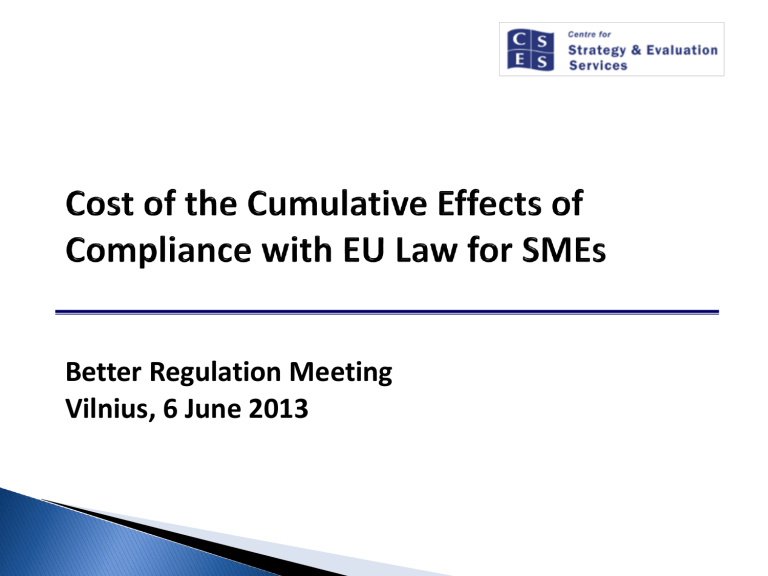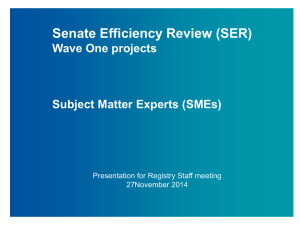Cost of the Cumulative Effects of Compliance with EU Law for SMEs

Better Regulation Meeting
Vilnius, 6 June 2013
Overview
Study objectives and research plan
Existing research on measuring the cost of EU regulation
Methodological issues and questions for discussion
www.cses.co.uk
2
Study objectives
Develop an appropriate methodology to assess the cost of the cumulative effects of compliance with EU law for Small and Mediumsized Enterprises (SMEs).
Identify and analyse the current situation of SMEs in Europe regarding
cost generated by the compliance with existing EU legislation and its national implementation and application in five sectors. The intention is to apply this methodological approach to commercial activity inside a given Member State, cross-border to other Member States as well as cross-border outside the EU.
Assess cumulative effects on SMEs of complying with regulatory
requirements of different natures and scopes incumbent on individual companies in specific economic sectors, and comparing the cost thereof in different countries. www.cses.co.uk
3
Research plan
www.cses.co.uk
4
Scope of the study
The research focuses on 9 Member States - Germany, Italy, Poland, Spain,
Estonia, Sweden, Ireland, Slovenia and Slovakia.
Within each country, 5 sectors have been selected that fulfil the following criteria: o Present in all Member States covered by the study o “Vital” to those economies o Comparable o Similar relative size in the Member States o Sufficient absolute size to enable robust sample sizes o Data about the economic activity must be available
The selected sectors are: Food and Drink/Food Retail, Manufacture of
Machinery and Equipment, Construction, Computer and Information
Services, and Transport www.cses.co.uk
5
Existing research
There is quite a lot of existing research on the costs and effects to business of EU laws but very little on the cumulative costs and effect.
As part of Phase 1 of the study, CSES has carried out a literature review to identify methodological approaches/options for assessing the cost of the cumulative effect of EU laws. In existing research, four generic methodologies were identified: o Business perception surveys o Compliance cost/benefit studies o Cross-national surveys o Qualitative studies
The first approach is the most common. Each approach has its advantages
and disadvantages. They are to a certain extent complementary and it is possible to combine elements of each approach. www.cses.co.uk
6
Methodological issues
Which costs associated with EU regulations should be included in an assessment - direct financial costs, opportunity and psychological compliance costs, long term structural costs, etc?
Many existing studies ignore the effects/benefits of regulation. Which effects should be included and how can the dynamic effects of regulation be best assessed, for example, where regulation stimulates adaptation in business processes and products?
How should the concept of cumulative effects be understood - the combined effect of different EU laws; EU and national laws; cumulative effects on SMEs over time?
How can the costs/effects on firms at different stages in the business
lifecycle (start up, expansion, etc) be captured? Should an assessment of cumulative costs/effects seek to capture the wider value chain, e.g. the costs/effects on firms involved in stages in the food processing/retailing? www.cses.co.uk
7
SMEs generally find it difficult to assess how EU laws affect their activities.
Which approach to obtaining information from SMEs is best? Possibilities include: o
SMEs might be asked an open-ended question regarding the EU regulations they believe affect them or prompted to answer specific questions about particular EU regulations.
o
An alternative approach is to focus on ‘events’ in the business lifecycle
(e.g. hiring an employee, developing new product), asking SMEs how
EU regulations affect they way they handle these ‘events’.
Given the complexity of the subject matter, and the focus of research on particular EU laws/sectors/countries, to what extent is it possible to produce findings that are likely to be more widely applicable? www.cses.co.uk
8











